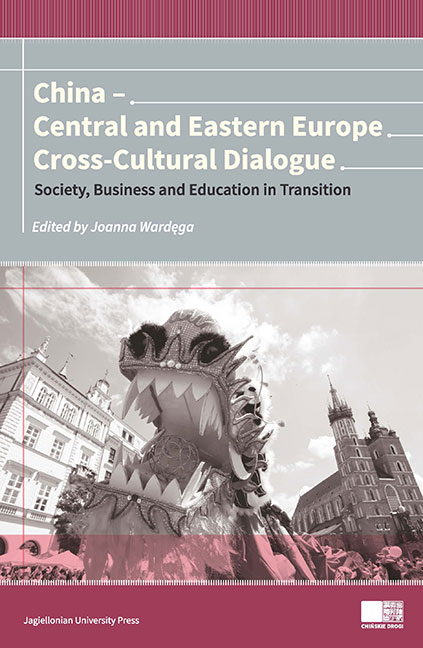Book contents
- Frontmatter
- Contents
- Foreword
- PART I Society and Culture in Transition
- PART TWO Economy and Markets in Transition
- Chinese Economic Influence on the Central and Eastern Europe Countries
- The New Silk Road and its Geopolitical Consequences for Poland
- Comparing Chinese, Japanese and South Korean FDI in Central and Eastern Europe
- Partnership through Investment – Chinese Foreign Direct Investment in CEE Countries
- Chinese Foreign Direct Investments in Europe. The Polish Case
- Fourteen EU States Already in, Japan and USA Still not Interested – What Lies Behind China-led AIIB?
- What Can CEE and China Learn from Each Other in Innovation?
- Comparison of Telecommunications Development Pattern in China and the Republic of Macedonia
- Development of Chinese Mobile Phone Game Market as an Export Opportunity for CEE Mobile Game Producers
- PART THREE Education in Transition
- Contributors
What Can CEE and China Learn from Each Other in Innovation?
from PART TWO - Economy and Markets in Transition
Published online by Cambridge University Press: 22 December 2017
- Frontmatter
- Contents
- Foreword
- PART I Society and Culture in Transition
- PART TWO Economy and Markets in Transition
- Chinese Economic Influence on the Central and Eastern Europe Countries
- The New Silk Road and its Geopolitical Consequences for Poland
- Comparing Chinese, Japanese and South Korean FDI in Central and Eastern Europe
- Partnership through Investment – Chinese Foreign Direct Investment in CEE Countries
- Chinese Foreign Direct Investments in Europe. The Polish Case
- Fourteen EU States Already in, Japan and USA Still not Interested – What Lies Behind China-led AIIB?
- What Can CEE and China Learn from Each Other in Innovation?
- Comparison of Telecommunications Development Pattern in China and the Republic of Macedonia
- Development of Chinese Mobile Phone Game Market as an Export Opportunity for CEE Mobile Game Producers
- PART THREE Education in Transition
- Contributors
Summary
Innovation, viewed in general terms as a tool to overcome economic growth slowdowns, has become a buzzword for many decision-makers and scientists. It is usually presented as a rescue path for economies that have already reached a certain, relatively comfortable income level, but are unable to move forward with their current economic growth model. Emerging economies have been attempting to alter their economic strategies to recover their growth rates in a sustainable manner. In addition, the governments with upper-middle income or high-income status think about creative reconstruction of their economic growth models.
The global financial crisis caused economic detriment in many sectors, and no economy was spared. Some managed to resume decent economic growth, while others never really recovered. Similarly, many East Asian economies, for example South Korea and Taiwan, overcame the financial crisis in the 1990s very well, while others like Japan, experienced a “lost decade” of economic stagnation. It seems as though as these economies were trapped in a pre-crisis stage missing out on essential economic reforms and remaining at the same level of development. This situation can be a natural growth slowdown that usually appears after strong growth periods, or it can represent a more sophisticated condition that can be called a “middle income trap”.
The term “middle-income trap” (MIT) was first introduced by World Bank economists in relation to economic development in East Asia (Gil et al., 2007), and is therefore a relatively new term to describe the slowdown of previously very rapidly growing economies. Although the current literature does not offer a formal MIT definition, it can be described as a situation when “middle-income economies have a low probability of sustaining sufficiently high growth rates to join the high-income group” (Han et al., 2015). The World Bank uses gross national income (GNI) per capita to measure economies’ capacity to provide well-being to its citizens. “Countries with average incomes of $12,476 (measured at 2011 prices) or more are classified as high income or developed economies” (World Bank, 2013). Therefore, countries need to exceed this threshold to become members of the high-income club, and for some, reaching this threshold was a difficult task. The most evident victim of this trap, often cited as retrospective proof of the MIT theory are Latin American economies that struggled to achieve high-income levels despite achieving middle-income status decades ago.
- Type
- Chapter
- Information
- China - Central and Eastern Europe Cross-Cultural Dialogue Society, Business and Education in Transition , pp. 277 - 290Publisher: Jagiellonian University PressPrint publication year: 2016



